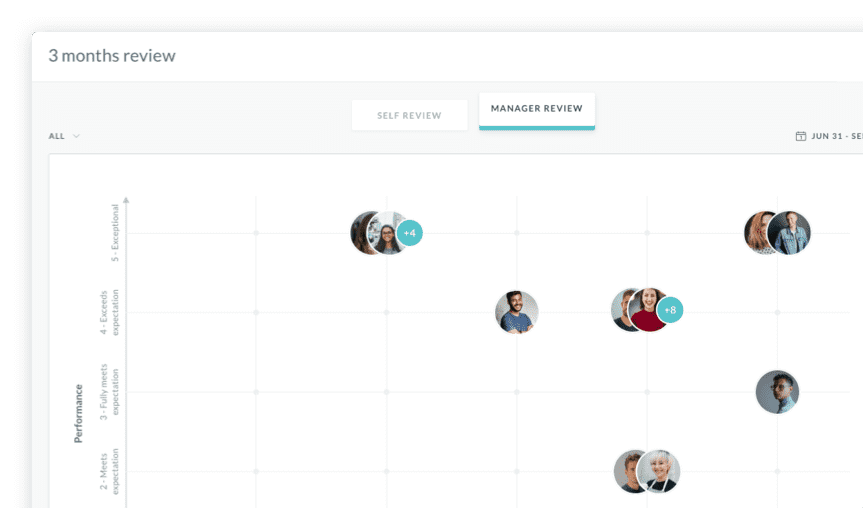Goals and objectives work together to elevate your business to where it needs to be. Although the two are interdependent, they are not interchangeable. While goals refer to the desired results, objectives are the activities that ensure progress towards the outlined goals.
Each team is unique and therefore needs varying strategies to work together to fulfill the overall company or business goals. There’s no one-size-fits-all approach that ensures peak performance so you must find a balance between goals vs. objectives. This balance will help you design initiatives that optimize your team’s capabilities and potential.
Let’s explore the role of goals and objectives in the workplace while discussing their importance to you and your team.
1. What are Goals and Objectives?
Goals and objectives provide focus and structure that empower your team with a sense of purpose.
A goal is the expected outcome, which should be ambitious but achievable. It can be long-term or short-term and primarily focuses on the business's operational, financial, and productivity health. For instance, a goal can be reducing employee turnover, increasing revenue, or adopting new operating procedures.
The best approach to use when creating strategic and clear plans is the SMART method. This means crafting Specific, Measurable, Attainable, Realistic, and Time-bound goals.
The most popular types of goals are:
-
Process-oriented goals- These goals focus on changing workflows, systems, and processes. Instead of focusing on particular results, process goals involve the methods your team utilizes to finish tasks.
-
Outcome-oriented goals- These goals promote significant changes in the business plan or performance. They involve measurable, smaller steps toward the desired results.
-
Time-bound goals- These goals involve particular objectives and have a time limit.
Objectives, on the other hand, provide a road map or action plan for your overall goals. They are measurable efforts with specific targets and are typically time-bound. You can easily determine objectives by breaking down primary goals into small, achievable steps.
Effective objectives allow your team to focus more on manageable steps instead of the broader outcomes. It becomes easy for your team to understand which actions to take to achieve success while motivating them to embrace the final goals.
Common types of objectives are such as:
-
Operational objectives- These objectives encourage team collaboration and ensure everyone remains on track. They become short-term benchmarks for the business strategy.
-
Tactical objectives- These objectives ensure alignment between the long-term milestones and the short-term workflows or deliverables.
-
Strategic objectives- Such objectives help you visualize long-term goals by providing direction, vision, and structure to your team.
Importance of Setting Clear Goals and Objectives
It’s vital to align goals and objectives as it’s an excellent and effective way to ensure success. Creating goals without related objectives increases the risk of failing to achieve your goals.
Goals don’t outline how to attain them but they determine the direction of your efforts. They should be in line with your business’s vision and mission.
Some outstanding benefits of clear goals and objectives include:
-
Goals provide direction for your team’s efforts, enabling everyone to move in the same direction. Objectives help you determine your progress toward the broader goals.
-
Goals assist in prioritizing, allowing you to focus on achievements that have the most impact on your business. Objectives give your team a sense of achievement, motivating employees to pursue the ultimate goals.
-
Achievable goals instill confidence in your team, as they understand the targets and how long they need to achieve the desired results. Clear objectives help to simplify and inform decision-making when unsure of the best way forward.
-
Goals motivate your team into action regardless of challenges while objectives determine the targets you expect of your team.
How Goals and Objectives Drive Organizational Success
Having measurable goals complimented by the right objectives helps your team enhance performance, monitor progress, and prioritize efforts. They become a common language that you can use to ensure collective collaboration that drives success.
Adopting an effective goal-setting strategy keeps your business's operational execution and strategic leadership aligned, allowing you to set, pursue, and evaluate key goals.
Goals provide a target, focus, and direction while objectives simplify the mission and vision into smaller and easier steps. Additionally, both offer evidence of tangible progress and transparency, helping your team handle challenges and enhance collaboration and performance management.

 Try Out Our
Try Out OurEmployee Engagement Software For Free


2. The Purpose of Goals in the Workplace
Setting goals in the workplace is an excellent way to positively impact your team's productivity and business success. Goals determine where and how everyone utilizes resources, time, and energy.
Concrete goals and objectives provide actionable ways to keep team members motivated and focused.
Setting Strategic Goals
Strategic goals propel your business toward a well-outlined direction that will ultimately lead to long-term success. Having such a direction helps your team achieve the overall goals by focusing on smaller steps.
1) Establishing Long-term Direction
Goals are big-picture and long-term objectives, not short-term plans that address a new challenge or issue.
Goals outline where your business needs to be, and provide particular targets or desired end results. They help you translate your vision statement into more meaningful and time-sensitive OKRs through qualitative and quantifiable results.
2) Inspiring and Motivating Employees
Most leaders find it challenging to maintain high team morale. Setting goals and objectives is a simple yet effective way to keep everyone energized and motivated. Team members can direct their energy and time towards activities that boost productivity. This in turn results in higher job satisfaction and a confidence boost.
3) Fostering Innovation and Growth
Pacesetters in any industry understand that clear objectives and goals have a positive impact on team alignment, productivity, and motivation. Your business’s success largely depends on the collective skills and knowledge of your team. It’s therefore vital to nurture a culture of continuous growth and innovation.
Such a proactive approach ensures everyone continuously refines existing skills while acquiring new ones. It empowers you and your business to thrive and adapt to dynamic market conditions. It becomes easier to attract and retain top talent, which encourages creativity and innovation.
Furthermore, setting goals can help team members think creatively, navigate new challenges, and create new ideas. It’s the best way to remain relevant in your industry and maintain a competitive edge.
Achieving Operational Goals
Every business or company requires clear strategic objectives and vision to ensure sustainable growth. Operational goals turn strategic planning into achievable OKRs, supported by performance management.
They provide time-sensitive KPIs (Key Performance Indicators) or targets. You can easily monitor long-term and short-term objectives.
1) Improving Efficiency and Productivity
Businesses have to adapt as necessary if they wish to foster an environment that encourages growth and performance.
Having clear expectations and goals is a vital factor that impacts efficiency and productivity. It provides a sense of purpose and direction, making everyone understand how their efforts affect the business.
2) Enhancing Team Collaboration
Teams require common factors to work effectively and goals bring together employees, regardless of their roles. Synergy and effort co-ordination help teams work toward a shared direction which ensures positive outcomes.
3) Evaluating Performance and Progress
Outlining objectives and goals correctly and accurately can help you assess your business’s success and team performance. Employees become more accountable for their work when they have defined targets to focus on.
Team members understand your expectations and are more likely to deliver outstanding quality.
3. The Importance of Objectives in the Workplace
When your team knows what you expect from them, they have higher chances of attaining and exceeding those expectations. Instead of wasting valuable time on fruitless tasks, they can confidently deliver outstanding quality while optimizing time.
Objectives serve as a way to keep employees on course and working toward an over-arching company goal.
They provide focus, and direction, set expectations, and also provide motivation for your workforce.
Defining Specific Objectives
Defining particular objectives brings out their real value. When every team member understands what you expect from them, it’s easier for them to relate how they contribute to the broader goals.
This aligns individual objectives with your vision, business strategy, and goals.
1) Breaking Down Goals into Actionable Steps
Objectives break down goals into smaller steps, clarifying the direction your team needs to take, which ensures sustainable progress.
2) Providing Clarity and Focus
Objectives provide clarity and focus by providing a well-defined and precise understanding of the desired outcome. They enable you to outline details such as when, how, why, and what your goals are.
With a clear vision and OKRs, it's easy to evaluate progress, remain focused, and outline priorities.
3) Enhancing Accountability and Measurement
Objectives require team members to take responsibility for their decisions, performance, behavior, and actions. Such accountability is a robust catalyst for higher performance, commitment, and success.
Aligning Objectives with Goals
Aligning objectives with goals brings more clarity to everyone's responsibilities and expectations, especially in a remote work culture where face-to-face interactions are limited so it's easy to misinterpret some actions. In addition to enhancing employee engagement, it instills motivation to perform better as team members know how their daily activities tie to the business objectives.
Such a goal-centric environment keeps your team moving towards the right goals and fosters a positive work culture.
1) Ensuring Consistency and Alignment
Creating alignment between individual goals and business objectives is a great way to ensure consistency. It forms the basis for improving productivity as your team understands the business's strategic objectives, mission, and vision.
2) Building a Framework for Success
Objectives give daily activities purpose and direction, making it easier to handle emerging challenges. Focusing on particular outcomes and the tasks that truly matter enhances time management and efficiency while keeping your team motivated.
3) Adapting Objectives to Changing Priorities
Any change in priorities calls for a review of your objectives. After all, objectives are your priority so these two aspects should shift and grow together.
It’s essential to keep objectives revisable and amendable. They should reflect the change and growth you wish to see in your business.

4. Balancing Goals and Objectives for Success
Most successful businesses outline ambitious yet achievable goals and objectives. Break down the overall goals into clear objectives and communicate the same to everyone. Getting this right within your business establishes a strong foundation for future success.
Integrating Goals and Objectives
Setting business objectives and goals may seem easy, but it’s essential to note that these goals shouldn’t be related to only what you want to achieve. There needs to be a direct relationship between your business strategy and KPIs (key performance indicators) or OKR (objectives and key results). These quantifiable success measures help your team justify why they need and should achieve the goals.
1) Creating a Cohesive Strategy
It's crucial to have a cascading relationship between KPIs, objectives, and goals. KPIs link to objectives, which then link to goals. Creating such a cohesive strategy helps everyone understand precisely how initiatives and tasks contribute to top-level objectives and goals.
2) Engaging Employees in Goal Setting
There’s a deep connection between goal setting and motivation. Empowering your team to define individual and team goals keeps everyone engaged. They know the direction to move and have the motivation brought by a sense of ownership over the business goals.
3) Adjusting Objectives to Meet Evolving Goals
Adaptability and flexibility are key pillars of effective goal-setting. Learning how to adjust objectives based on how the goals evolve helps your business adapt to dynamic market conditions.
It involves identifying how to maintain the goal’s essence and core while keeping an open mind to explore different methodologies and plans.
Monitoring Progress and Adjusting Course
Regular progress monitoring is an effective way to keep your business goals and objectives achievable and relevant. It makes it easier to modify goals to adapt to changing market conditions. Additionally, it enables your team to identify potential challenges and leverage new opportunities.
1) Implementing Regular Check-ins and Reviews
Maintaining a continuous feedback loop ensures adaptability and sustainability. Implement a system that promotes regular check-ins and reviews to evaluate employee progress toward the OKRs and overall goals.
Schedule team check-ins and individual meetings to discuss challenges, celebrate accomplishments, and plan how to pivot accordingly.
2) Identifying Challenges and Roadblocks
When breaking down goals into achievable objectives, it’s essential to consider potential hurdles your team may face. Discussing and anticipating these roadblocks in advance enables your team to devise creative contingency plans and solutions
3) Making Data-Driven Decisions for Improvement
Data is an invaluable and robust asset for any business. Grounding your goals and objectives in data simplifies progress monitoring and tracking while ensuring transparency. Access to real-time results and updates helps your team achieve targets and adjust as necessary to maintain productivity and performance.

To learn more about Perform by HR Cloud, download one pager now
5. Conclusion
Goals and objectives have an impressive potential to inspire a mindset of purpose, growth, and progress. They help to foster a work environment that encourages continuous improvement.
Creating objectives and setting goals is an iterative process that requires continuous realignment, refinement, and evaluation. It's a learning process that aims to keep your business agile and resilient to changing conditions.
Learning how to balance goals vs. objectives can empower you to design initiatives that optimize your team’s potential.
Author Bio:
Nisha Joseph is a Content Manager of Profit.co. In her current role, she leads the content marketing team with experience in various fields, such as science, education, law, and management. She is a well-rounded individual with diverse interests and skills.
Keep Reading
Balancing Technology and the Human Touch in Employee Engagement
Companies are taking employee engagement very seriously because it is one of the ways of
Building Strong Teams: The Power of Team Bonding Exercises
Never overestimate the power of collaboration as a core element of effective team

